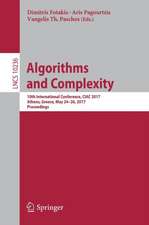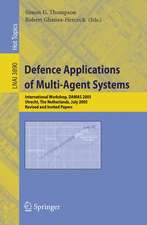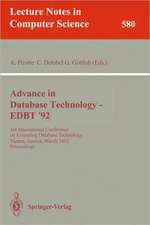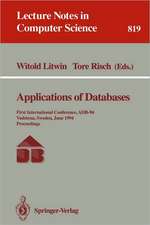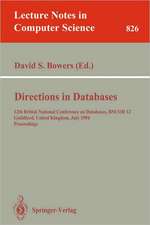Applied Evolutionary Algorithms in Java
Autor Robert Ghanea-Hercocken Limba Engleză Hardback – 30 apr 2003
| Toate formatele și edițiile | Preț | Express |
|---|---|---|
| Paperback (1) | 329.44 lei 6-8 săpt. | |
| Springer – 24 iul 2012 | 329.44 lei 6-8 săpt. | |
| Hardback (1) | 647.93 lei 6-8 săpt. | |
| Springer – 30 apr 2003 | 647.93 lei 6-8 săpt. |
Preț: 647.93 lei
Preț vechi: 809.92 lei
-20% Nou
Puncte Express: 972
Preț estimativ în valută:
123.99€ • 132.58$ • 103.37£
123.99€ • 132.58$ • 103.37£
Carte tipărită la comandă
Livrare economică 17 aprilie-01 mai
Preluare comenzi: 021 569.72.76
Specificații
ISBN-13: 9780387955681
ISBN-10: 0387955682
Pagini: 219
Ilustrații: XIII, 219 p.
Dimensiuni: 155 x 235 x 17 mm
Greutate: 0.49 kg
Ediția:2003
Editura: Springer
Colecția Springer
Locul publicării:New York, NY, United States
ISBN-10: 0387955682
Pagini: 219
Ilustrații: XIII, 219 p.
Dimensiuni: 155 x 235 x 17 mm
Greutate: 0.49 kg
Ediția:2003
Editura: Springer
Colecția Springer
Locul publicării:New York, NY, United States
Public țintă
ResearchCuprins
1 Introduction to Evolutionary Computing.- 1.1 Evolutionary Computation.- 1.2 History of Evolutionary Computing.- 1.3 Obstacles to Evolutionary Computation.- 1.4 Machine Learning.- 1.5 Problem Domains.- 1.6 Applications.- 1.7 Evolution-Based Search.- 1.8 Summary.- Further Reading.- 2 Principles of Natural Evolution.- 2.1 Natural Selection.- 2.2 DNA Structure.- 2.3 Summary.- Further Reading.- 3 Genetic Algorithms.- 3.1 Genetic Algorithms.- 3.2 GA Basics.- 3.3 GA Theory.- 3.4 GA Operators.- 3.5 Pros and Cons of Genetic Algorithms.- 3.6 Selecting GA methods.- 3.7 Example GA Application.- 3.8 Summary.- Further Reading.- 4 Genetic Programming.- 4.1 Genetic Programming.- 4.2 Introduction to Genetic Programming.- 4.3 GP Operators.- 4.4 Genetic Programming Implementation.- 4.5 Summary.- Further Reading.- 5 Engineering Examples Using Genetic Algorithms.- 5.1 Introduction.- 5.2 Digital Image Processing.- 5.3 Basics of Image Processing.- 5.4 Java and Image Processing.- 5.5 Spectrographic Chromosome Representation.- 5.6 Results.- 5.7 Summary — Evolved Image Processing.- 5.8 Mobile Robot Control.- 5.9 Behaviour Management.- 5.10 Evolutionary Methods.- 5.11 Fuzzy logic Control.- 5.12 Evolved Fuzzy Systems.- 5.13 Robot Simulator.- 5.14 Analysis.- 5.15 Summary — Evolving Hybrid Systems.- Further Reading.- 6 Future Directions in Evolutionary Computing.- 6.1 Developments in Evolutionary Algorithms.- 6.2 Evolvable Hardware.- 6.3 Speciation and Distributed EA Methods.- 6.4 Advanced EA techniques.- 6.5 Artificial Life and Coevolutionary Algorithms.- 6.6 Summary.- Further Reading.- 7 The Future of Evolutionary Computing.- 7.1 Evolution in Action.- 7.2 Commercial value of Evolutionary Algorithms.- 7.3 Future Directions in Evolutionary Computing.- 7.4 Conclusion.- Appendix A.- A.1Java-based EA Software.- A.2 C/C++ based EA Software.- A.3 General Evolution and Robotics References.- A.4 Java Reference Guides.- A.5 Useful References.- Appendix B.- A Genetic Algorithm Example and the GPSYS GP Library.- B.1 Basic Genetic Algorithm.- B.2 Simple Java Genetic Algorithm.- Exercises.- B.2.1 Vectors and Arraylists.- B.3 Application Design.- B.4 Eos: An Evolutionary and Ecosystem Research Platform.- Authors: Erwin Bonsma, Mark Shackleton and Rob Shipman.- B.4.1 Introduction.- B.4.2 Design Overview.- B.4.3 Key Classes.- B.4.4 Configuration.- B.4.5 Illustrative Example Systems.- B.4.6 Aerial Placement for Mobile Networks.- B.4.7 An Ecosystem Simulation Based on Echo.- B.4.8 Coevolutionary Function Optimisation.- B.4.9 Telecommunications Research using Eos.- B.4.10 NetGrow: A Telecommunications Application.- B.4.11 Eos Summary.- B.5 Traveling Salesman Problem.- B.5.1 EOS Traveling Salesman Problem.- B.6 Genetic Programming.- B.6.1 Observations from Running GPsys — Lawnmower Problem.- Eos References.- Appendix C.- C.1 Fuzzy Logic.- C.2 Fuzzy Set Theory.- C.2.1 Fuzzy Operators.- C.2.2 Linguistic Variables.- C.2.3 Fuzzy IF.- C.2.4 Fuzzy Associative Memories.- C.2.5 Fuzzy Control Systems.- C.2.6 Defuzzification.- C.2.7 Fuzzy Applications.- C.3 Limitations of Fuzzy Control.- C.3.1 Advantages of Fuzzy Systems.- C.4 Summary.- Further Reading.- Appendix D.- System Overview.- Use and License.- Programming Language and Run-Time Environment.- Top-Level Directory Files and Hierarchy.- Units of Measure.- The Client-Server Architecture.- Network/Local Connections Versus Dynamically Loaded Clients.- Why a Client-Server Architecture?.- Client-Server Communications.- Network and Local Connection Issues.- Communication via Events and Requests.- Keeping the RPI ProtocolLanguage-Independent.- Configuration Elements and Properties Files.- The “port” and “hostName” Properties.- Overriding Properties.- Loading RsProperties Files as a Resource.- The Server.- Server Properties Files.- Accepting Clients.- The Scheduler.- The Floor Plan.- Syntax and Semantics.- Building a Virtual Robot.- Thinking About Client Design.- The Demonstration Clients.- Life Cycle of the Demonstration Clients.- How ClnMain Extends RsClient and Implements RsRunnable.- The RsRunnable Interface.- Building RsRunnable and RsClient into ClnMain.- DemoMain Implements RsRunnable, But Does Not Extend RsClient.- The Execution of ClnMain.- Uploading the Body Plan.- Registering Event Handlers.- Running the Event Loop.- How the Demo Clients Work.- Physical Layout of ClientZero.- The RsBody and RsBodyPart Classes.- RsBodyShape.- RsWheelSystem.- The Sensor Classes.- RsBodyTargetSensor.- RsBodyContactSensor.- Events and Requests.
Recenzii
From the reviews:
"The book of Ghaenea Hercock gives a good overview of many artificial intelligence approaches, developed in the course of the years. … Students and computer scientists, who look for an overview of evolutionary algorithms, will receive a well readable composition of the most important procedures." (W. Brecht, Zentralblatt MATH, Vol.1041 (16), 2004)
"This succinct volume from Springer aims to provide an introduction to evolutionary algorithms (both genetic algorithms and genetic programming) from an application point of view, with specific emphasis on the use of the Java programming language. The latter emphasis marks out the book from other more general introductions to the subject … . In all this is a useful introduction to a fascinating subject. … it serves as a useful adjunct for those interested in applications and/or Java implementations." (TechBookReport, October, 2003)
"The book of Ghaenea Hercock gives a good overview of many artificial intelligence approaches, developed in the course of the years. … Students and computer scientists, who look for an overview of evolutionary algorithms, will receive a well readable composition of the most important procedures." (W. Brecht, Zentralblatt MATH, Vol.1041 (16), 2004)
"This succinct volume from Springer aims to provide an introduction to evolutionary algorithms (both genetic algorithms and genetic programming) from an application point of view, with specific emphasis on the use of the Java programming language. The latter emphasis marks out the book from other more general introductions to the subject … . In all this is a useful introduction to a fascinating subject. … it serves as a useful adjunct for those interested in applications and/or Java implementations." (TechBookReport, October, 2003)












